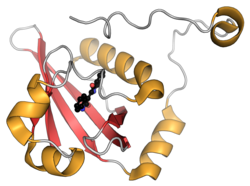The aryl hydrocarbon receptor (also known as AhR, AHR, ahr, ahR, AH receptor, or as the dioxin receptor) is a protein that in humans is encoded by the AHR gene. The aryl hydrocarbon receptor is a transcription factor that regulates gene expression. It was originally thought to function primarily as a sensor of xenobiotic chemicals and also as the regulator of enzymes such as cytochrome P450s that metabolize these chemicals. The most notable of these xenobiotic chemicals are aromatic (aryl) hydrocarbons from which the receptor derives its name.
More recently, it has been discovered that AhR is activated (or deactivated) by a number of endogenous indole derivatives such as kynurenine. In addition to regulating metabolism enzymes, the AhR has roles in regulating immune cells, stem cell maintenance, and cellular differentiation.[5][6][7]
The aryl hydrocarbon receptor is a member of the family of basic helix-loop-helix transcription factors. AhR binds several exogenous ligands such as natural plant flavonoids, polyphenols and indoles, as well as synthetic polycyclic aromatic hydrocarbons and dioxin-like compounds. AhR is a cytosolic transcription factor that is normally inactive, bound to several co-chaperones. Upon ligand binding to chemicals such as 2,3,7,8-tetrachlorodibenzo-p-dioxin (TCDD), the chaperones dissociate resulting in AhR translocating into the nucleus and dimerizing with ARNT (AhR nuclear translocator), leading to changes in gene transcription.
- ^ a b c GRCh38: Ensembl release 89: ENSG00000106546 – Ensembl, May 2017
- ^ a b c GRCm38: Ensembl release 89: ENSMUSG00000019256 – Ensembl, May 2017
- ^ "Human PubMed Reference:". National Center for Biotechnology Information, U.S. National Library of Medicine.
- ^ "Mouse PubMed Reference:". National Center for Biotechnology Information, U.S. National Library of Medicine.
- ^ Esser C (2016). "The Aryl Hydrocarbon Receptor in Immunity: Tools and Potential". Suppression and Regulation of Immune Responses. Methods in Molecular Biology. Vol. 1371. pp. 239–57. doi:10.1007/978-1-4939-3139-2_16. ISBN 978-1-4939-3138-5. PMID 26530806.
- ^ Kawajiri K, Fujii-Kuriyama Y (May 2017). "The aryl hydrocarbon receptor: a multifunctional chemical sensor for host defense and homeostatic maintenance". Experimental Animals. 66 (2): 75–89. doi:10.1538/expanim.16-0092. PMC 5411294. PMID 27980293.
- ^ Gutiérrez-Vázquez C, Quintana FJ (January 2018). "Regulation of the Immune Response by the Aryl Hydrocarbon Receptor". Immunity. 48 (1): 19–33. doi:10.1016/j.immuni.2017.12.012. PMC 5777317. PMID 29343438.




